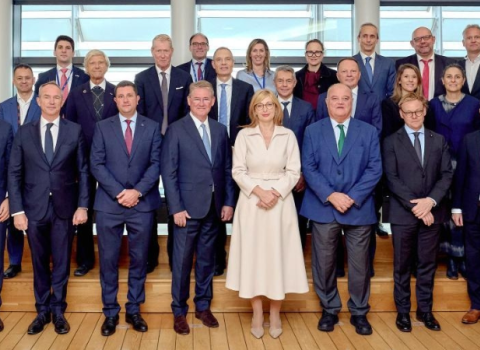
These are among a list of ten key areas for action drawn up by the 22-member board, after a peer review process. The list was requested by the EU Commissioner for Research, Innovation and Science, Máire Geoghegan-Quinn, as input to her wide-ranging review of EU innovation policy. That policy will be published in early October, setting the stage for months of debate among the EU member-states about the future direction of EU R&D funding and policies.
The Commissioner called on ERAB to give her a list of actions she can focus on delivering at a conference which took place in May this year under the Spanish Presidency. “Provide me with at least ten concrete proposals on how research, innovation and science can contribute to address society’s grand challenges,” she told academics, industrialists and policy makers gathered at the meeting in Seville.
In response to Geoghegan Quinn, and based on the intense discussions at the Seville conference, ERAB has now delivered its top ten action list in its latest report, Towards a new Renaissance. The report follows on from an earlier ERAB document last year, setting out 76 recommendations for EU action: Preparing Europe for a New Renaissance. A Strategic View of the ERA.
John Wood, Chair of ERAB, said the ten actions stem from fundamental imperatives, “We must take more risk. We must open up our organisations and systems. We must not stifle creativity, especially amongst the young. We must attract, not drive away, top talent. We must promote excellence and cohesion in society, encourage open innovation, [and] integrate science into the policy-making process.”
The ten actions are:
Short-term (Immediate action)
1. Create a single EU-wide patent and an Open Innovation Charter, within 2 years.
2. Agree on a fast-track timeline for a full and widespread implementation of pre-commercial procurement of research and development.
3. Concentrate research and innovation funding around a selection of themes that are relevant for the upcoming EU 2020 strategy (Europe 2020: A strategy for smart, sustainable and inclusive growth). These should be “man on the moon-type” projects that capture the public imagination. For example:
smart and green growth: realise a zero carbon public transport system;
aging graciously: a socio-tech environment to be able to live with dignity at home.
4. Create an annual European City/Region of Innovation, with criteria matching the Grand Challenges (for example, meeting carbon emissions targets, having 70 per cent of citizens engaged in “citizen science”, a 50 per cent reduction in working days lost on health grounds).
5. Issue an EU Framework Directive on Research & Innovation focusing particularly on creating a single market for Research and Innovation. This directive should address and make propositions to:
harmonise and strengthen public and pre-commercial procurement schemes;
create a European Research Certificate/Passport to enhance mobility of researchers;
support pan-European Graduate/Research Schools focused on Grand Challenges, including the possibility of developing a high-level European PhD;
foster flexible cross-border research funding;
establish a European Peer review College for projects addressing Grand Challenges.
Mid-Term (3-5 years)
6. Implement pre-commercial procurement of R&D around a few commonly agreed big projects, for example to:
procure 50 quantum computers of a certain specification;
develop an accelerator-driven nuclear plant to eradicate long term radioactive waste;
produce equipment for large-scale artificial photosynthesis.
7. When FP8 starts, ensure funding is concentrated and streamlined by:
minimising management obligations for all funding schemes;
earmarking 30 per cent of the Structural Funds and 10 per cent of the Common Agricultural Policy for dedicated research and innovation;
creating a commonly accepted set of research output metrics based on research impact and innovation delivery.
8. Foster an acceptable degree of risk taking and excellence throughout all Research and Innovation programmes by accepting that research and innovation will take unexpected paths as new ideas are explored. Minimise application paperwork by setting limits for each call and create independent but accountable bodies that can best foster this environment for all areas of Research and Innovation.
9. Create a European Venture Capital fund capable of investing in early stage proof of concept and business development prior to commercial investment.
Long-Term (5+ years)
10. Make result and risk-oriented funding of research and innovation projects the dominant criterion for research and innovation funding of the EC by reducing the fiscal burden on Research Technology and Development labour throughout Europe to a level comparable or better than our main competitors.
Summing up, Wood said that taking these steps will help Europe, “To solve our Grand Challenges and make the European Research Areas both stronger in itself and in its role in the wider world of research and innovation.”
Science|Business acted as rapporteur at the conference and in the preparation of ERAB’s first report.





 A unique international forum for public research organisations and companies to connect their external engagement with strategic interests around their R&D system.
A unique international forum for public research organisations and companies to connect their external engagement with strategic interests around their R&D system.